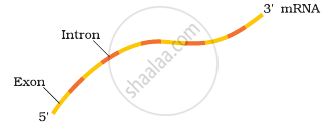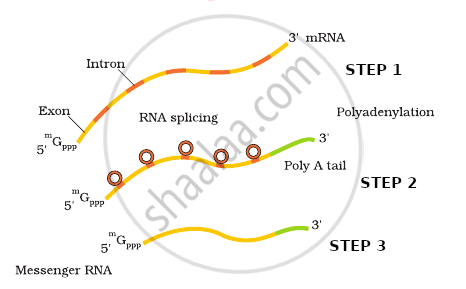Advertisements
Advertisements
Question
Observe the segment of mRNA given below.

(a) Explain and illustrate the steps involved to make fully processed hnRNA?
(b) Gene encoding RNA Polymerase I and III have been affected by mutation in a cell. Explain its impact on the synthesis of a polypeptide, stating the reasons.
Solution
(a) The hnRNA undergoes processes called capping and tailing followed by splicing. In capping, an unusual nucleotide is added to the 5'-end of hnRNA methyl guanosine triphosphate. In tailing, adenylate residues (about 200 - 300) are added at the 3'-end in a template-independent manner. Now the hnRNA undergoes a process where the introns are removed and exons are joined to form mRNA called splicing.

(b) The process of translation will not happen, thus the polypeptide synthesis is stopped/hampered.
The reason for the above is:
RNA polymerase I transcribe rRNAs which is the cellular factory for protein synthesis.
RNA polymerase III helps in the transcription of tRNA which is the adaptor molecule that transfers amino acids to the site of protein synthesis.
APPEARS IN
RELATED QUESTIONS
Depending upon the chemical nature of the template (DNA or RNA) and the nature of nucleic acids synthesised from it (DNA or RNA), list the types of nucleic acid polymerases.
Differentiate between the following:
mRNA and tRNA
Explain the process of transcription in Eukaryotes.
With regard to mature mRNA in eukaryotes.
If the base sequence of a codon in mRNA is 5'-AUG-3', the sequence of tRNA pairing with it must be ______.
Ribozyme is a/an:
The most abundant type of RNA in the cell is ______.
Sigma factor is a component of ______.
The exon part of mRNA has code for ______
Identify the correct statement.
